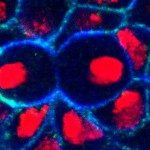Link to Pubmed [PMID] – 27070787
PLoS Genet. 2016 Apr;12(4):e1005984
The Notch pathway controls proliferation during development and in adulthood, and is frequently affected in many disorders. However, the genetic sensitivity and multi-layered transcriptional properties of the Notch pathway has made its molecular decoding challenging. Here, we address the complexity of Notch signaling with respect to proliferation, using the developing Drosophila CNS as model. We find that a Notch/Su(H)/E(spl)-HLH cascade specifically controls daughter, but not progenitor proliferation. Additionally, we find that different E(spl)-HLH genes are required in different neuroblast lineages. The Notch/Su(H)/E(spl)-HLH cascade alters daughter proliferation by regulating four key cell cycle factors: Cyclin E, String/Cdc25, E2f and Dacapo (mammalian p21CIP1/p27KIP1/p57Kip2). ChIP and DamID analysis of Su(H) and E(spl)-HLH indicates direct transcriptional regulation of the cell cycle genes, and of the Notch pathway itself. These results point to a multi-level signaling model and may help shed light on the dichotomous proliferative role of Notch signaling in many other systems.
